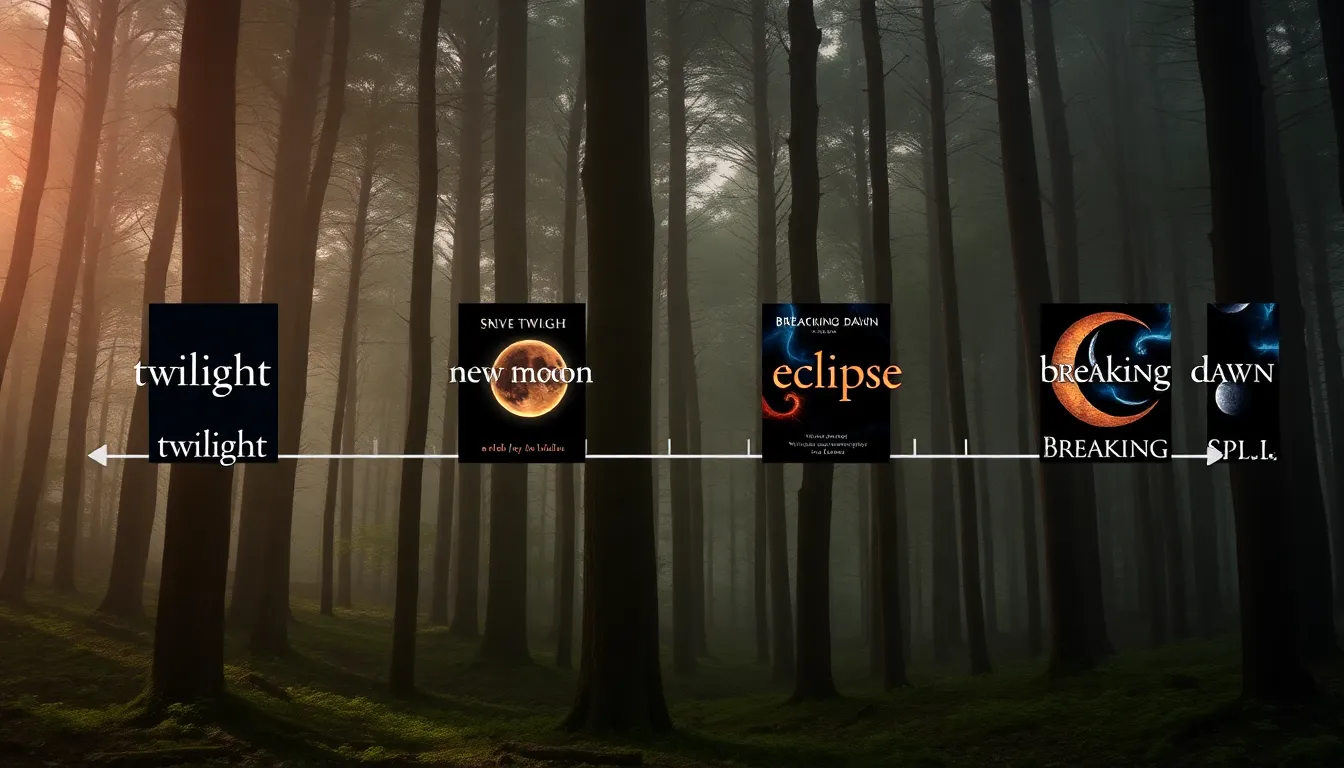The Twilight series captivated readers around the world with its blend of romance and supernatural intrigue. This iconic saga, penned by Stephenie Meyer, introduced fans to the passionate love story between Bella Swan and Edward Cullen, a vampire with a complicated past.
The first book, Twilight, hit the shelves in 2005, igniting a phenomenon that would lead to a dedicated fanbase and a successful film franchise. Subsequent titles, including New Moon, Eclipse, and Breaking Dawn, followed closely behind, each contributing to the series’ lasting impact on young adult literature and pop culture.
As readers reminisce about their first encounters with this enchanting world, it’s fascinating to explore the timeline of the books’ releases and how they shaped a generation’s love for fantasy and romance.
Table of Contents
ToggleOverview of Twilight Series
The Twilight series consists of four novels—Twilight, New Moon, Eclipse, and Breaking Dawn—written by Stephenie Meyer.
Twilight debuted on October 5, 2005. The novel introduces readers to Bella Swan, a human, who falls in love with Edward Cullen, a vampire. This installment set the stage for a passionate love story intertwined with supernatural themes.
New Moon followed on August 21, 2006. In this book, Bella faces heartbreak as Edward leaves Forks, creating a deeper exploration of longing and friendship, particularly with Jacob Black, a werewolf.
Eclipse, released on August 7, 2007, escalates tension among vampires and werewolves. Bella must choose between her love for Edward and her friendship with Jacob, intensifying the series’ central conflicts.
Breaking Dawn, published on August 2, 2008, concludes the series with Bella’s transformation into a vampire and the challenges that accompany her new life. This final installment resolved major plot threads and introduced Bella and Edward’s daughter, Renesmee.
Together, these novels shaped a significant cultural phenomenon, influencing young adult literature and spawning a lucrative film franchise. The series’ legacy continues, captivating new generations of readers with its blend of romance and fantasy.
Release Timeline of Twilight Books

The Twilight series includes four main novels, each contributing to the overarching narrative. Below is the detailed timeline of their releases.
Twilight
Twilight was first published on October 5, 2005. This initial installment introduces Bella Swan and her romance with Edward Cullen, setting the foundation for the series’ themes of love and supernatural conflict.
New Moon
New Moon followed on August 21, 2006. This sequel explores Bella’s emotional turmoil after Edward leaves her, highlighting her deepening friendship with Jacob Black and expanding the series’ universe through the introduction of werewolf mythology.
Eclipse
Eclipse was released on August 7, 2007. This third book intensifies the stakes, showcasing the conflict between vampires and werewolves as Bella grapples with her feelings for both Edward and Jacob, further developing the central love triangle.
Breaking Dawn
Breaking Dawn debuted on August 2, 2008. The final novel in the series depicts Bella’s transformation into a vampire and the challenges that arise with her new life, including the complexities of motherhood and the implications of her daughter Renesmee’s existence.
Impact of Twilight Series
The Twilight series significantly influenced young adult literature and popular culture. It fostered a resurgence of vampire-themed stories, leading to a wave of similar novels and media. Authors such as Richelle Mead and P.C. Cast credit the series for elevating the popularity of supernatural themes in their works.
The series sparked a dedicated fanbase, with readers actively participating in online discussions, fan fiction, and conventions. Book sales reflected this enthusiasm, with over 100 million copies sold worldwide. The films, beginning with Twilight in 2008, grossed over $3.3 billion collectively, introducing the story to a broader audience.
The love triangle between Bella Swan, Edward Cullen, and Jacob Black generated extensive dialogue about romance, choice, and identity among teens. The series created a cultural touchstone, inspiring merchandise, parody, and literary analyses. Schools even utilized the books to engage students in reading and discussion.
Twilight also impacted the film industry, setting trends in young adult adaptations. It led to adaptations of other series, such as The Hunger Games and Divergent, showcasing the potential for box office success in this genre. Its legacy continues to shape contemporary young adult literature, establishing new expectations for storytelling and character development.
The Twilight series has left an indelible mark on literature and pop culture since its debut in 2005. Its unique blend of romance and supernatural elements resonates with readers of all ages. The journey of Bella, Edward, and Jacob continues to spark discussions and inspire new narratives in young adult fiction.
With over 100 million copies sold and a successful film franchise, Twilight’s influence extends beyond its pages. It has shaped the landscape of modern storytelling, paving the way for future adaptations and new voices in the genre. This series not only captivated a generation but also established a lasting legacy that continues to engage fans worldwide.









